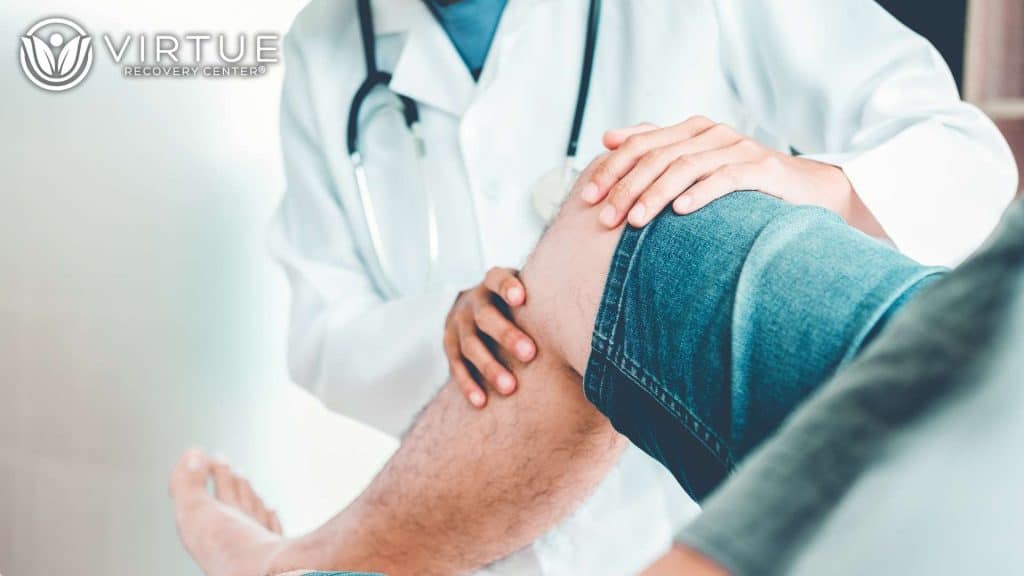Key Takeaways
- Opioids can help with pain, but they also come with risks like dependence, misuse, and addiction.
- Long-term opioid use may not be the best choice for treating chronic pain.
- Safer pain relief options include non-opioid medications, physical therapy, and emotional support.
- Open communication and careful planning can lower the chances of addiction.
Introduction
Pain is something almost everyone deals with at some point. Whether it’s a pulled muscle, a bad back, or pain after surgery, it can seriously affect how we feel and function. For many people, the first treatment offered is a prescription opioid, like oxycodone or hydrocodone.
Opioids can work well—especially for short-term or severe pain. But they also carry serious risks if used the wrong way or for too long. That’s why it’s so important to know how to manage pain safely.
This article explains how you can reduce the risk of addiction while still getting the relief you need. If you’re using opioids or considering them for pain, this information could help protect your health.
Understanding Opioids and How They Work
Opioids are powerful pain relievers that work by attaching to special spots in the brain called opioid receptors. When they do, they block pain messages and create a calming or even euphoric effect.
Common opioids include:
- Oxycodone (OxyContin, Percocet)
- Hydrocodone (Vicodin)
- Morphine
- Fentanyl
- Codeine
These medications are used for both acute pain (like after an injury or surgery) and chronic pain (lasting more than three months). But when used for a long time, opioids can lead to serious problems.
Why Opioid Use Can Lead to Addiction
At first, opioids might seem like a miracle. They reduce pain and help you move or sleep. But the longer they’re used, the more the body gets used to them. This is called tolerance—meaning you need more of the drug to get the same effect.
As tolerance grows, your body may develop dependence, which means it needs the drug just to feel normal. If you stop suddenly, you may feel withdrawal symptoms, like sweating, shaking, or anxiety.
This is how opioid addiction, or opioid use disorder, can begin—even for people who start taking them as prescribed. Addiction can affect anyone, especially those with a history of trauma, mental health challenges, or other substance use.
The Risks of Long-Term Opioid Therapy
Using opioids for weeks or months at a time increases the risk of:
- Addiction
- Overdose
- Hormone problems
- Depression or mood changes
- Constipation and other digestive issues
- Decreased ability to function daily
Studies from the American Pain Society and Substance Abuse and Mental Health Services Administration (SAMHSA) show that long-term opioid use doesn’t always help with pain. In fact, it can sometimes make things worse, especially for chronic non-cancer pain, like back or joint pain.
Better Ways to Manage Chronic Pain
You don’t have to choose between being in pain or risking addiction. Many people find relief from non-opioid treatments that target both the body and the mind.
Here are some safer pain management options:
1. Non-opioid medications
Drugs like acetaminophen (Tylenol), ibuprofen (Advil), or certain antidepressants and anticonvulsants can ease nerve and muscle pain. These don’t carry the same addiction risk.
2. Physical therapy
Stretching, strength training, and movement therapy can reduce pain, improve function, and help people avoid the need for medication altogether.
3. Cognitive Behavioral Therapy (CBT)
Pain isn’t just physical—it affects your emotions, too. CBT teaches people how to change their thoughts about pain and develop coping skills.
4. Nerve blocks and injections
For some people, a shot in the right place can stop pain for weeks or months without daily medication.
5. Mind-body practices
Techniques like yoga, meditation, and biofeedback can help calm the nervous system and reduce the brain’s response to pain.
How Doctors Can Prescribe Opioids More Safely
When opioids are needed, doctors can take steps to lower the risks. Safe opioid prescribing includes:
- Using the lowest effective dose
- Setting clear goals for pain relief and function
- Limiting the duration of use (days, not weeks)
- Avoiding high-risk combinations (like opioids and benzodiazepines)
- Monitoring use through regular visits, pill counts, or urine tests
- Checking state prescription monitoring programs to prevent duplicate prescriptions
Good doctors also talk openly with patients about the risks of opioid use and explore non-drug alternatives whenever possible.
What You Can Do as a Patient
If you’re being treated for pain, there are steps you can take to protect yourself.
- Ask questions: Find out what the medication is, how long you’ll take it, and what the plan is for stopping it.
- Speak up about concerns: If you’re feeling too drowsy, anxious, or notice cravings, tell your doctor.
- Avoid alcohol or sedatives while taking opioids. This combination increases the chance of overdose.
- Keep track of your pain, your medication, and any side effects in a journal.
- Store medication safely and never share it with anyone else.
- Dispose of leftover pills properly to prevent misuse by others.
Being part of your treatment plan gives you more control—and lowers the chance of addiction.
When to Seek Help for Opioid Misuse
Sometimes, even with the best plans, things can go wrong. If you or someone you love is showing these signs, it may be time to reach out:
- Taking more pills than prescribed
- Feeling like you need the drug just to function
- Experiencing mood swings or personality changes
- Trying to stop but being unable to
- Going to different doctors to get more medication
- Using opioids for emotional pain or stress
Opioid addiction doesn’t make someone weak or bad. It means they need support—and there is no shame in asking for help.
Support and Treatment at Virtue Recovery Chandler
At Virtue Recovery Chandler, we help people recover from opioid addiction while still addressing their underlying pain or emotional needs.
Our treatment programs include:
- Medical detox with 24/7 care
- Pain-informed therapy that addresses the mind-body connection
- Dual diagnosis support for people with anxiety, depression, or PTSD
- Relapse prevention and life skills training
- Family involvement and education
We know pain is real—and recovery is possible. We’re here to help every step of the way.
Conclusion
Pain treatment doesn’t have to come at the cost of your health. Opioids can be helpful in the right situation, but they should always be used with caution.
By working with your doctor, exploring other options, and staying informed, you can manage your pain without falling into addiction.
And if you or someone you care about is already struggling with opioid misuse, know that it’s not too late to get help.
Call 866-338-5779 today to speak with someone at Virtue Recovery Chandler. We’ll listen, support, and help you find a path forward.
FAQs
What is the safest way to treat chronic pain without opioids?
Non-opioid medications, physical therapy, and counseling are all effective ways to manage pain safely.
Can I become addicted to opioids even if I take them as directed?
Yes. Long-term use, even when taken correctly, can lead to tolerance, dependence, and addiction.
What are signs I might be misusing opioids?
Taking more than prescribed, craving the medication, or feeling “off” without it may be signs of misuse.
What should I do if I think I’m addicted to pain medication?
Talk to your doctor or reach out to a treatment center like Virtue Recovery Chandler at 866-338-5779.
Is there treatment that addresses both pain and addiction?
Yes. Many programs, including ours, offer integrated care that treats pain and addiction together for better results.
What is opioid use disorder and how can it affect patients with chronic pain?
Opioid use disorder is a medical condition characterized by an inability to control the use of opioid medications despite negative consequences. It can significantly impact patients with chronic pain by complicating their treatment plan and increasing the risk of opioid overdose and opioid dependence.
What are some effective strategies to reduce the risk of opioid abuse during pain management?
To reduce the risk of opioid abuse, healthcare providers can implement strategies such as careful patient selection, using non-opioid medications when possible, monitoring patients closely, and utilizing opioid therapy for chronic pain only when necessary. Additionally, educating patients about the risks of opioid medications is crucial.
How does opioid withdrawal manifest, and what should patients expect when discontinuing opioids?
Opioid withdrawal can present with symptoms such as anxiety, sweating, nausea, muscle aches, and insomnia. Patients tapering off opioid medications should be monitored and may require support or alternative treatments to manage withdrawal symptoms effectively.
What is the role of opioid medications in chronic pain management?
Opioid medications play a significant role in managing severe pain, particularly in patients with chronic pain who do not respond to other treatments. However, their use must be carefully balanced with the effectiveness and risks of long-term opioid therapy to avoid opioid misuse and abuse.
Are there alternative treatments for chronic pain that can reduce the reliance on opioids?
Yes, there are several alternative treatments for chronic pain that can reduce reliance on opioids, including physical therapy, cognitive-behavioral therapy, acupuncture, and non-opioid analgesics. These options can provide effective pain relief while minimizing the risks associated with opioid therapy.
How can patients and doctors work together to manage opioid dependence?
Patients and doctors can collaborate by establishing a clear treatment plan that includes regular follow-ups, discussions about the effectiveness of long-term opioid therapy, and exploring non-opioid options. Open communication about any concerns regarding opioid medication is essential for managing opioid dependence.
What are the risks associated with long-term opioid therapy for chronic pain?
The risks of long-term opioid therapy for chronic pain include the potential for opioid dependence, increased tolerance leading to higher opioid doses, and the risk of opioid overdose. Additionally, the effectiveness of long-term opioid therapy may diminish over time, necessitating careful evaluation of treatment strategies.
How do national institutes of health guidelines influence opioid prescribing practices?
National institutes of health guidelines provide evidence-based recommendations for prescribing opioids, emphasizing the importance of individualized treatment plans, thorough patient assessments, and ongoing monitoring to minimize the risks of opioid abuse and optimize pain management outcomes.
What should patients know about opioid therapy for chronic pain regarding its effectiveness versus placebo?
Patients should be aware that while opioid therapy can be effective for managing certain types of chronic pain, studies have shown that its effectiveness compared to placebo varies. This highlights the importance of considering other pain management options and being informed about the potential risks of long-term opioid use.
What are the signs of opioid overdose that patients and caregivers should be aware of?
Signs of opioid overdose include extreme drowsiness, slow or difficult breathing, and loss of consciousness. It is crucial for patients and caregivers to recognize these symptoms and seek immediate medical attention, as timely intervention can be lifesaving.
Resources
https://www.asam.org/docs/default-source/advocacy/opioid-addiction-disease-facts-figures.pdf







